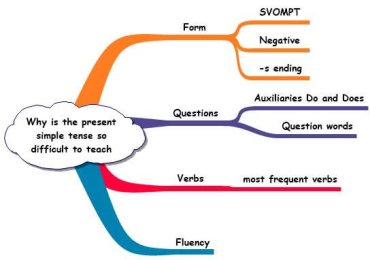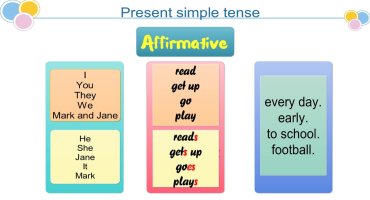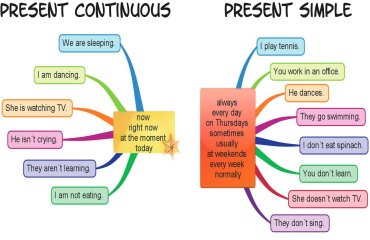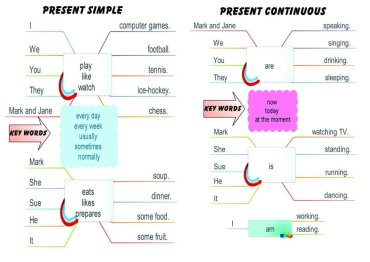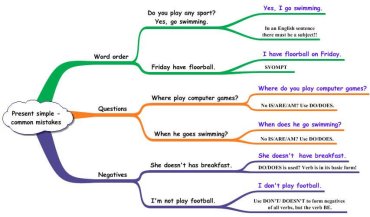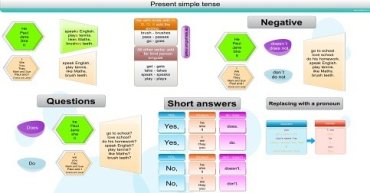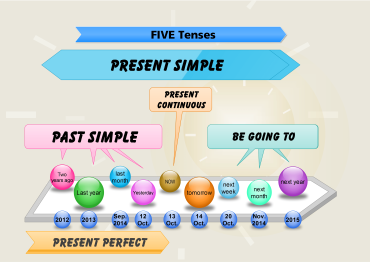The present simple tense is the most important tense for elementary students of English to learn. To be able to communicate intelligibly they need to master at least the basic rules. If they don´t they will struggle with many other grammar rules. Therefore it is crucial that they learn this tense.
But what does it mean to master the present simple tense? What do the students need to learn? In this post, I will list all the things you need to teach to help them with this grammar.
ADVERT:
[showmyads]
Present Simple – Form
1. SVOMPT
Many teachers and experts believe that the students will pick up the SVOMPT rule on their own. They believe that it is enough to provide the learners with enough input and this rule will take care of itself. They are wrong! It works in this way only with gifted students but not with the weaker ones. You need to teach this rule.
I have already created two posts on teaching SVOMPT. You can find the first one here and the second one here.
2. Negatives
In my experience, this rule is best mastered by using drills. Of course, we shouldn´t drill for hours on end, but 5 minutes in several consecutive lessons would be nice. For drilling I love using the following Drill table:

I love using the following video based on the drill table:
And to give my students a visual support to learn the negative form, I use the following graphic organiser:
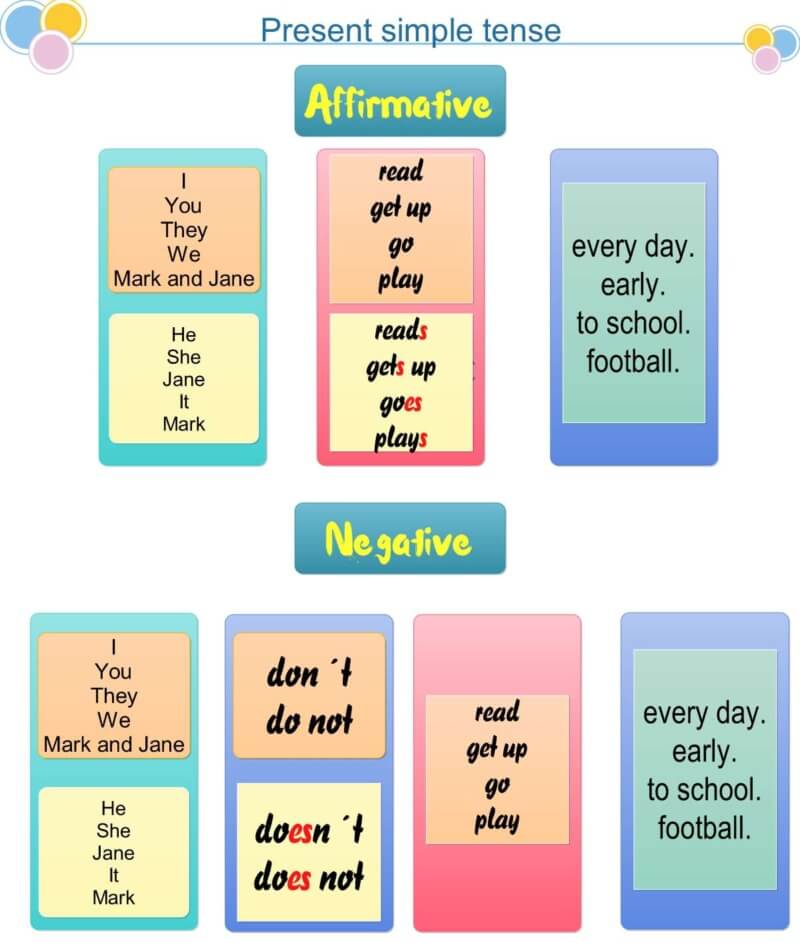
3. The -S ending
ADVERT:
[showmyads]
I personally don´t care much. If the students use English extensively, this will take care of itself in time. But there is no way to make the process any quicker. Of course, I would drill it and I would correct it but I wouldn´t worry about it too much.
Present Simple – Forming Questions
To form a question in the present simple tense, students need to use the auxiliary DO. It is not so difficult to explain. Once your students know the SVOMPT rule, just tell them to add DO at the beginning of the sentence. This “DO” informs the listener that the sentence is a question.
It isn´t difficult to understand. The problem is that in the third person singular they need to use the auxiliary DOES. To help my students I use the following drill table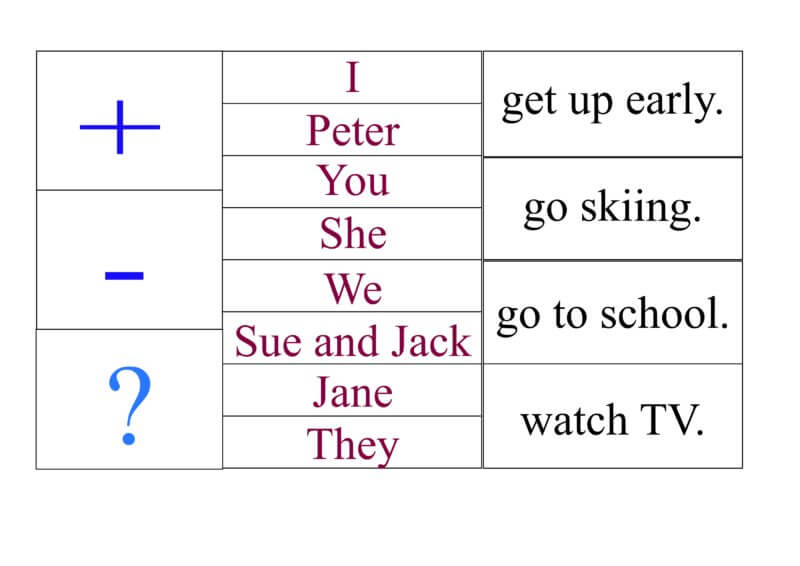
and the following graphic organiser:

Questions Words
Or you could edit the following mind map. It contains the question words and their Czech translation.
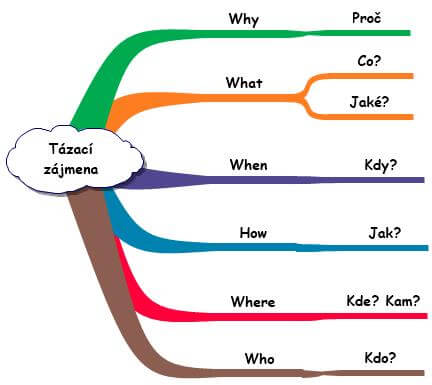
And now you might think that you are done with teaching the present simple tense. You are wrong! There are the short answers. While students can understand that they need to use the auxiliary DO again, they often fail to use the correct pronoun. To help them I have created the following post to teach just the short answers in the present simple tense.
VERBS
No, you can´t. Students need to know the verbs they could use the grammar with. The present simple tense is traditionally taught with the verbs for daily routines. But these verbs, though very useful, are not the most frequent ones in English. To teach our students real English it is necessary to introduce a batch of the really frequent verbs in English. The following list contains all the verbs that belong among the 250 most frequent words in English:
If you are looking for a way to teach the verbs, you can find some interesting methods for teaching vocabulary here.
Present Simple – Fluency
It is the verb LIKE. Students often fail to form the present simple tense correctly, but they produce the questions “What do you like?” and “Do you like One Direction?” correctly. How is this possible?
The answer is simple. The verb LIKE is used in many communicative exercises (sometimes the exercises do not contain any other verb) and students simply become fluent using this verb. Our goal is, however, to achive the same fluency with the other verbs too. But how? What can we do?
I have designed the following exercise to help my students become more fluent:
Moreover, when preparing communicative exercises, we need to use more verbs than just the verb LIKE.
Present Simple – Pronunciation
We cannot rely on the fact that our students will learn the present simple tense by ear. As the native speakers contract the pronunciation of the auxiliaries heavily, we cannot expect our students to pick them up just by listening. We need to teach the grammar.
Present simple – usage
If it is the first tense you teach, do not bother with explaining the usage. Teach the verbs, meaning and the form and explain the usage only once you introduce another tense.
Conclusion
You can use the following mind map to check that you taught everything:
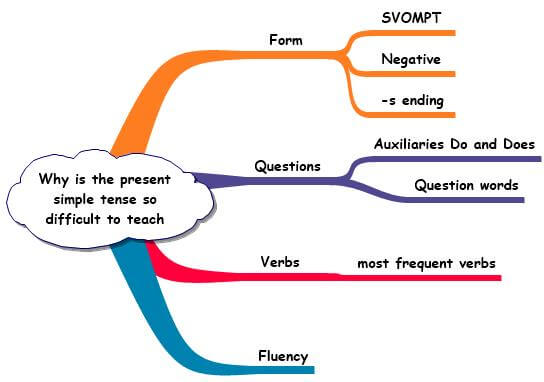
Please, share your ideas in the comments section.
In this post I would like to share 7 online quizzes to practise the present simple tense. All the quizzes are in HTML 5, so you or your students can play them on their mobile phones. Moreover, if you have a website or a wordpress site, you can easily enter these exercise there by copying the code under the quizzes.
<!– wp:more –>
ADVERT:
[showmyads]
Present simple – affirmative
To play the quiz on the full screen, click the button below:
Present tense affirmativeTo put this quiz on your website or wordpress site, just copy the following code:
<iframe width="710" height="480" src="https://engames.eu/Present simple/Quizzes/Present simple affirmative (Web)/index.html"></iframe>In the second quiz, students test their knowledge of the third person singular.
To play the quiz on the full screen, click the button below:
Third person affirmativeTo put this quiz on your website or wordpress site, just copy the following code:
<iframe width="710" height="480" src="https://engames.eu/Present simple/Quizzes/Present simple affirmative third person (Web)/index.html"></iframe>In the following quiz, students are asked to make the sentences negative.Present simple – Negative sentences
To play the quiz on the full screen, click the button below:
Present simple negativesTo put this quiz on your website or wordpress site, just copy the following code:
<iframe width="710" height="480" src="https://engames.eu/Present simple/Quizzes/Present simple negative (Web)/index.html"></iframe>In the following quiz, students practise forming questions in the present simple tense.Present simple – Questions
To play the quiz on the full screen, click the button below:
Questions in the present simple tenseTo put this quiz on your website or wordpress site, just copy the following code:
<iframe width="710" height="480" src="https://engames.eu/Present simple/Quizzes/Present simple questions (Web)/index.html"></iframe>In the fifth quiz, students can test their knowledge of the short answers in the present simple tense:
To play the quiz on the full screen, click the button below:
Questions and short answers in the present simple tenseTo put this quiz on your website or wordpress site, just copy the following code:
<iframe width="710" height="480" src="https://engames.eu/Present simple/Quizzes/Present simple questions (Web)/index.html"></iframe>To revise everything students have learnt about the present simple tense, there are two quizzes to do this.Present tense – Revision
In the first one, students have to tick all the sentences, that are grammatically correct.Choose the correct sentences
To play the quiz on the full screen, click the button below:To put this quiz on your website or wordpress site, just copy the following code:
<iframe width="710" height="480" src="https://engames.eu/Present simple/Quizzes/Present simple choose correct (Web)/index.html"></iframe>And in the last exercise, students try to choose the correct answer for each gap.
To play the quiz on the full screen, click the button below:
Present tenses revisionTo put this quiz on your website or wordpress site, just copy the following code:
<iframe width="710" height="480" src="https://engames.eu/Present simple/Quizzes/Present simple questions and affirmative (Web)/index.html"></iframe>
In this post I would like to share with you the best activities I know to teach the present simple tense.
To achieve this, I will recycle some of the materials I have already and shared here. However, there are several new materials (for example the infographic) which I designed just for this post.
<!– wp:more –>
ADVERT:
[showmyads]
I hope you find these materials useful and you will use them in your lessons.
Present simple – song
Here are the lyrics to complete:
Present simple songPresent simple – form
The aim of the following activity is to sensitize students to the forms of the present simple tense and to improve their pronunciation.
Play the following rhyme and ask the students to listen and then repeat it. In the last phase, students should read it on their own.
It is a good idea to ask your students to memorise the rhyme.
Present simple – infographic
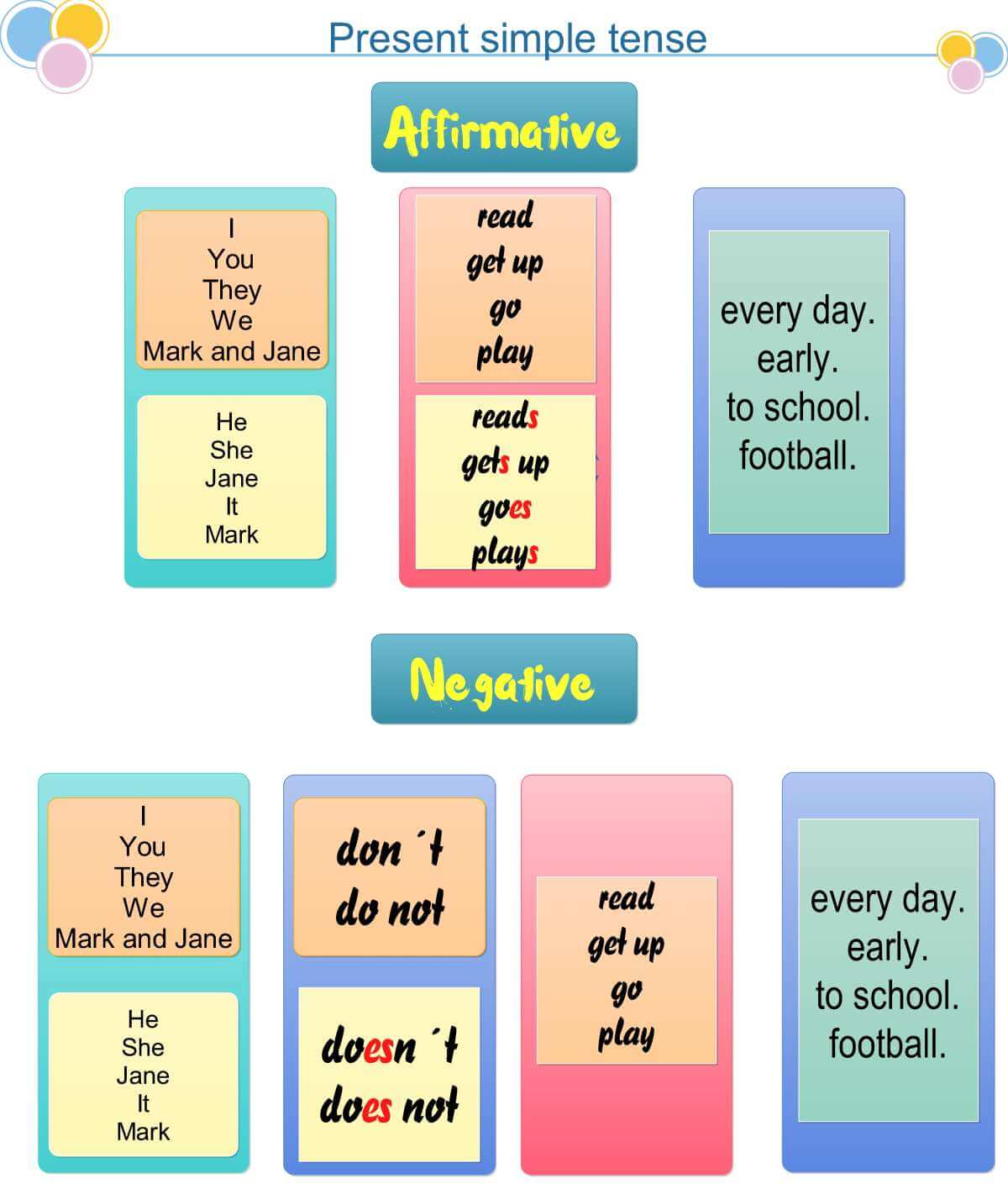
Print the picture for everyone and explain that students should use the ending -s with the third person singular.
You might want to teach the correct spelling of the -s ending, but I do not think it is a good idea. I believe, it is better to expose the students to the language now.
Present simple – story
Print the worksheet, so that every student has a copy. It is best to print the cards on a stronger paper. Ask the students to cut the cards and go through the cards and translate the expressions into the students´ MT. Students write the translation on the other side of each card.
Then students learn the new words using the flashcards.
Once they learn the words, play the following British Council video and ask the students to do the accompanying tasks. I think that tasks 1 and 4 are especially important.
ADVERT:
[showmyadsa]
Collect the texts your students write and correct them to see what problems your students have.
Present simple – grammar exercises
It is a good idea to teach the most frequent verbs in English here. Here are the flashcards for the most frequent verbs in English:
Most frequent English verbsIn my previous post I offered several resources to teach the difference between the present simple and present continuous tenses. There are several exercises and games including an infographic. But, as my students complained that the infographic was not that helpful I created a new one.
<!– wp:more –>
Advert:
[showmyads]
In this post there is an infographic explaining the usage of the two present tenses using the key words and then there is a quiz where the students can practise their knowledge of the grammar.
I hope you like it.
Teach the present tenses – infographic
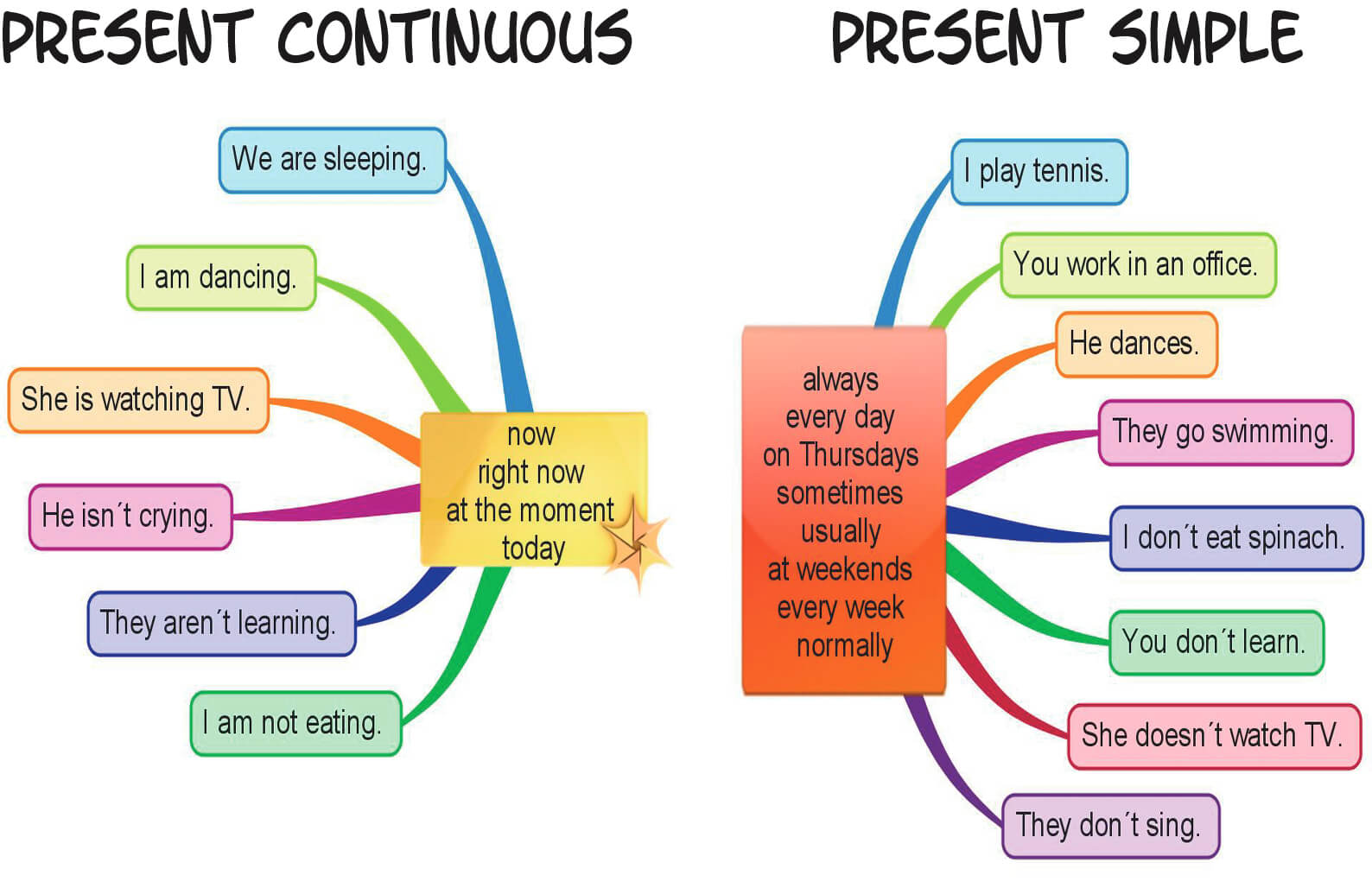
Elicit the usage of the present tenses. Students should understand that the present continuous tense is used when there are the words “now, at the moment, right now and today“.
If the words like “always, sometimes, on Tuesdays” etc. are used the present simple tense is often used.
Of course, this explanation is not 100% grammatically correct but for some students (and many textbook exercises) it works very well.
Emphasize that the students do not have to learn both of the lists. It is enough if they learn the words connected with the present continuous tense and use the present simple in all the other cases.
Present tenses – online quiz
Present tenses – online quiz
Present tenses – Darts
Type the correct answer and then score as many points possible.
ADVERT:
[showmyadsa]
Sometimes it is very difficult for students to decide whether they should use the present simple or the present continuous tense. To help them decide correctly, I will share several activities with you. These activities make it clear which tense the students should use and how to form it.
<!– wp:more –>
ADVERT:
[showmyads]
In this post there are two comic stories and an accompanying worksheet. Then there is an infographic focusing on the keywords which are often connected with the tenses. And the last activity is an interactive game to practise the usage of the two tenses.
Present simple or present continuous – Comics
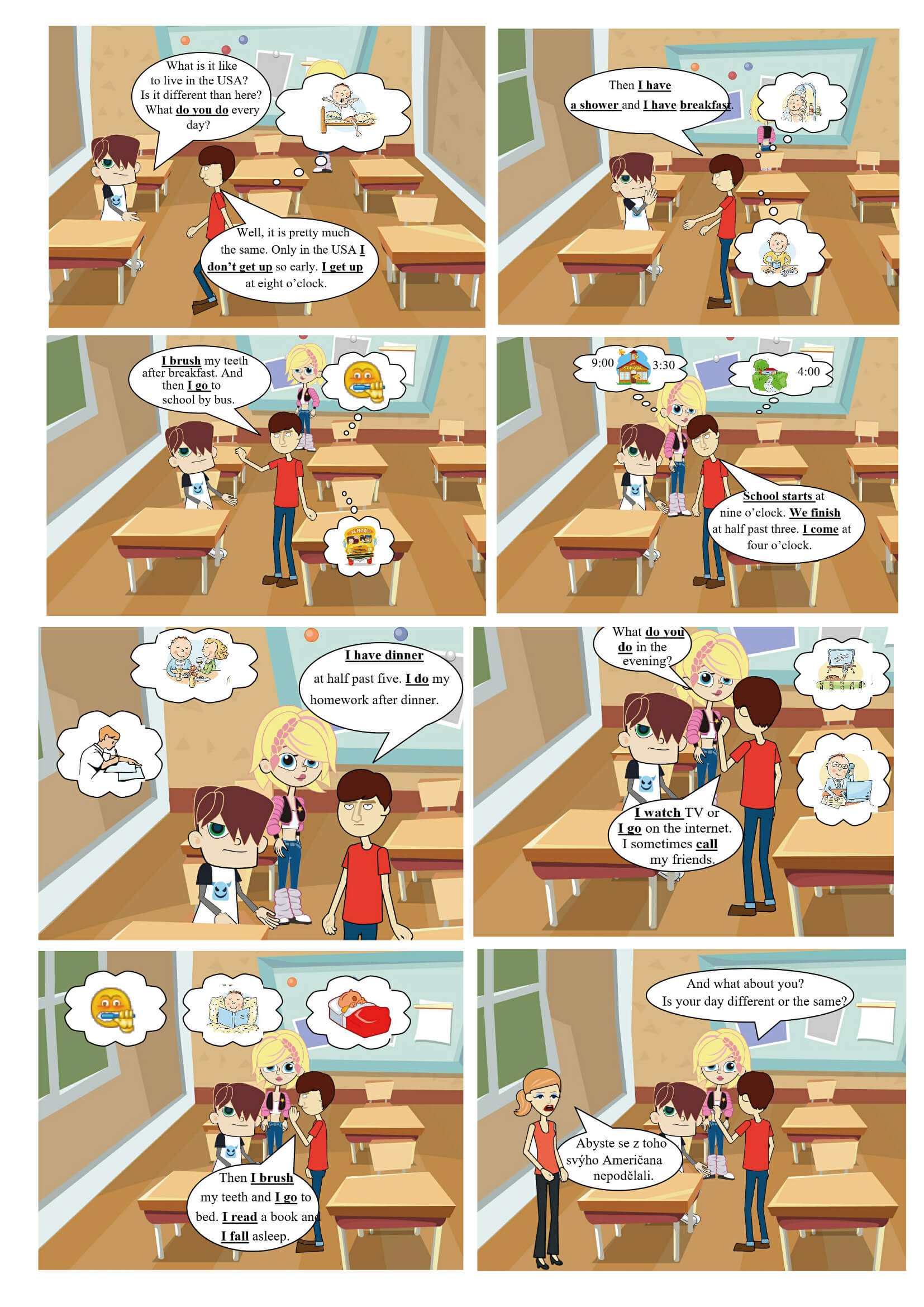
Now, print the following worksheet and your students should complete the first exercise.
Present simple worksheetCheck the answers and then ask the students to write sentences into the table in exercise 2. It is a good idea to elicit the first line before they start.
In the exercise 3, students write about their normal day.
As an additional activity, you can ask the students to use the comic story and retell the American´s day. Thus they can practise the third person singular.
Now, it is time to hand out the second comic.

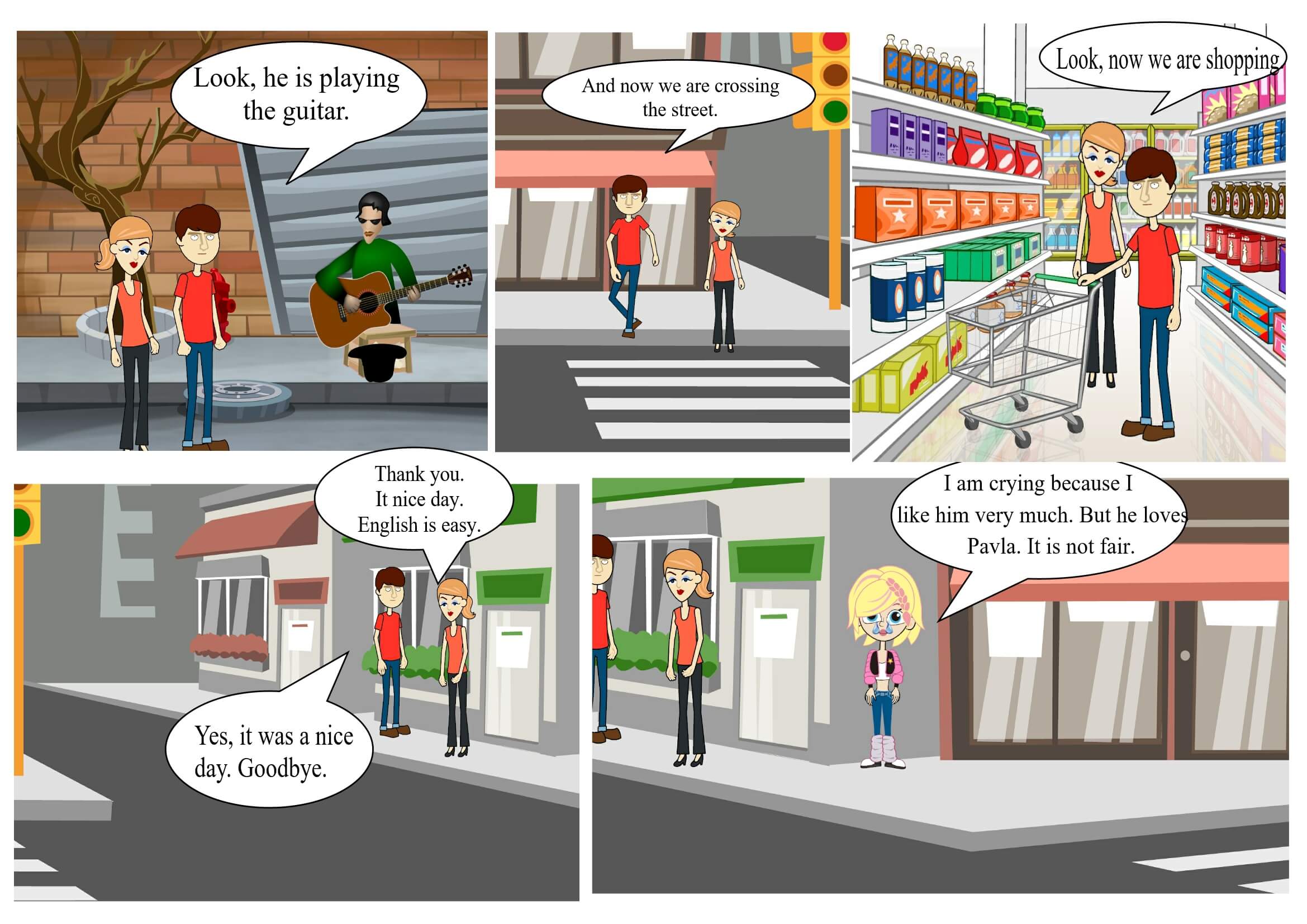
You can print the comic here:
Present continuous comicStudents should read the comic and answer the questions in exercise 4 in the worksheet above.
Present simple or present continuous – explanation
Others might profit from the following infographic which focuses on the key words.
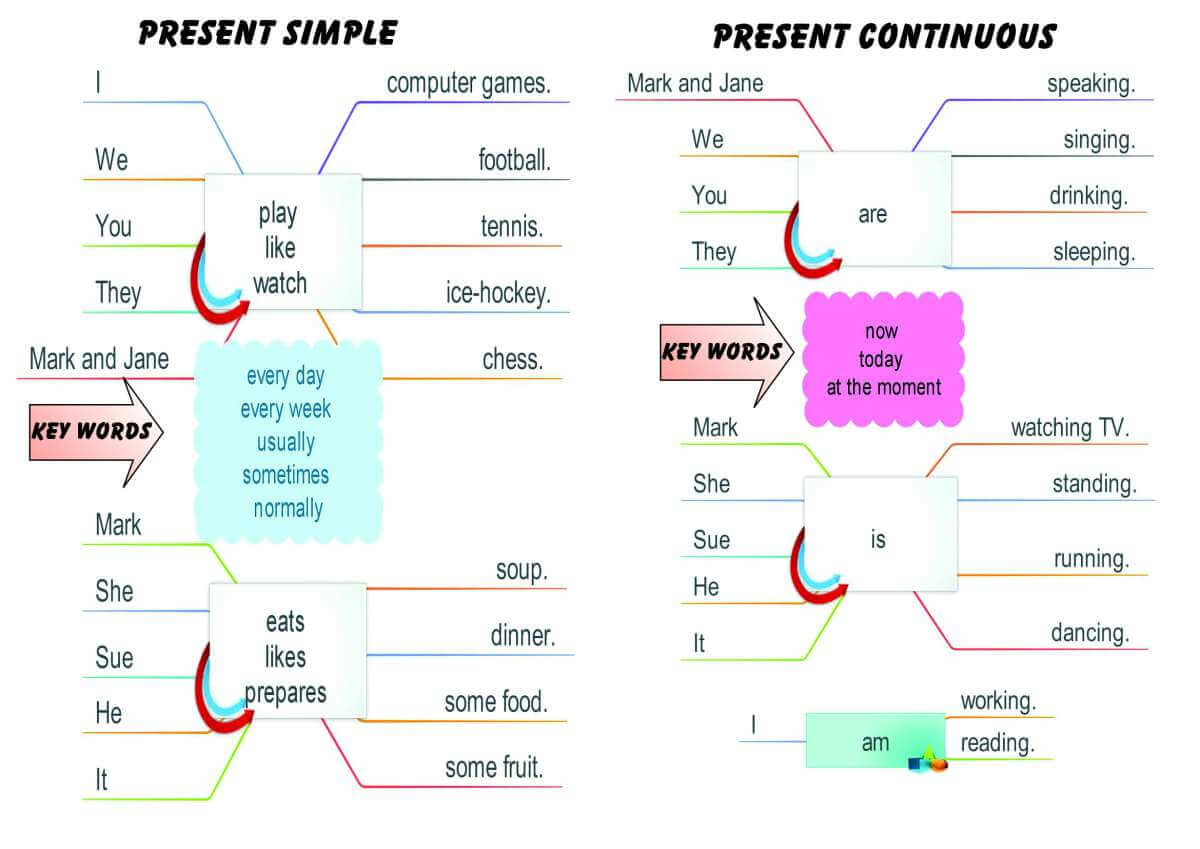
Present simple or present continuous – games
Students work in pairs. They choose a square where they would like to enter their cross or nought. However, they can do so only if they form a correct sentence using all the words of the coordinates for the given square. If they make a mistake they cannot draw anything. If they are not sure, they can check the sentence in the key grid.
The winner is the student who manages to draw four symbols next to each other.
The following game is called Quiz Darts. Your task is to put the verb in the correct tense and if you answer correctly, you can throw the dart. Your task is to score as many points as possible.
ADVERT:
[showmyadsa]
You can play the game on the full screen here:
Present tenses – darts game
Present simple or present continuous – more
The difference between present simple and continuous
Present simple or present continuous – improved
Present simple and continuous tenses
Which activity did you like best?
After teaching present simple to my elementary students, we wrote a test and I collected the most common mistakes my students made. I analysed the mistakes and prepared games and exercises to help my students learn from their mistakes.
In this post there is an infographic with all the mistakes, their corrections and explanations. Then there is a worksheet with 4 exercises, two games and an online quiz to practise the most difficult aspects of the present simple tense.
Common mistakes – present simple – infographic
In the mind map there are all the wrong sentences, their corrections and in blue ink there is an explanation why the sentence was wrong.
ADVERT:
[showmyads]
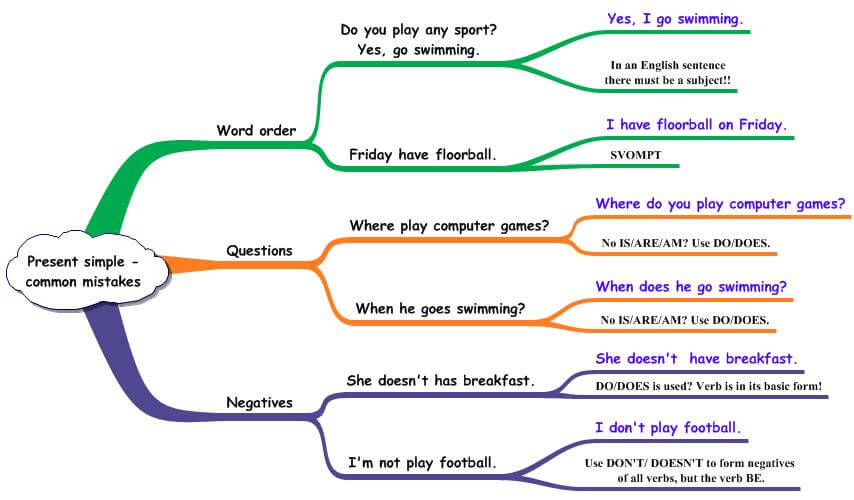
Common mistakes – present simple – worksheet
Only after this activity I display the infographic and explain the mistakes.
Then it is time to hand out the following worksheet:
Common mistakes in present simple tense worksheetIn the worksheet there are four exercises. The first one is slightly unusual. First the students have to decide where the verbs go and then they have to put the words into the correct order. The rest of the exercises are all standard exercises.
Common mistakes – present simple – games
The first game is called Penalty Shootout. In this game you should choose the correct form and then try to score a goal. Good luck.
As the game is in Flash, it will only play on desktop computers.
ADVERT:
[showmyadsa]
Present simple – Penalty game
The following quiz can help your students practise the past simple tense at home. The quiz consists of two parts. In the first part, students should put the words into the correct order. In the second part, students have to put the verbs into the correct form. Students will be rewarded with a game after each part of the quiz they pass. The quiz is in HTML5, so it will play on all desktops and mobile devices.
Present simple tense – quizPresent simple is one of the most important tenses in English. It is quite easy to teach and learn but it must be done properly. In this post I am going to teach some vocabulary first and then teach the forms using the verbs.
ADVERT:
[showmyads]
In this post you can find a worksheet, a video and an interactive quiz to teach the vocabulary for daily activities. Once your students know the verbs it is time to introduce the forms – present simple tense affirmative, present simple tense negative and present simple tense questions.
Daily activities
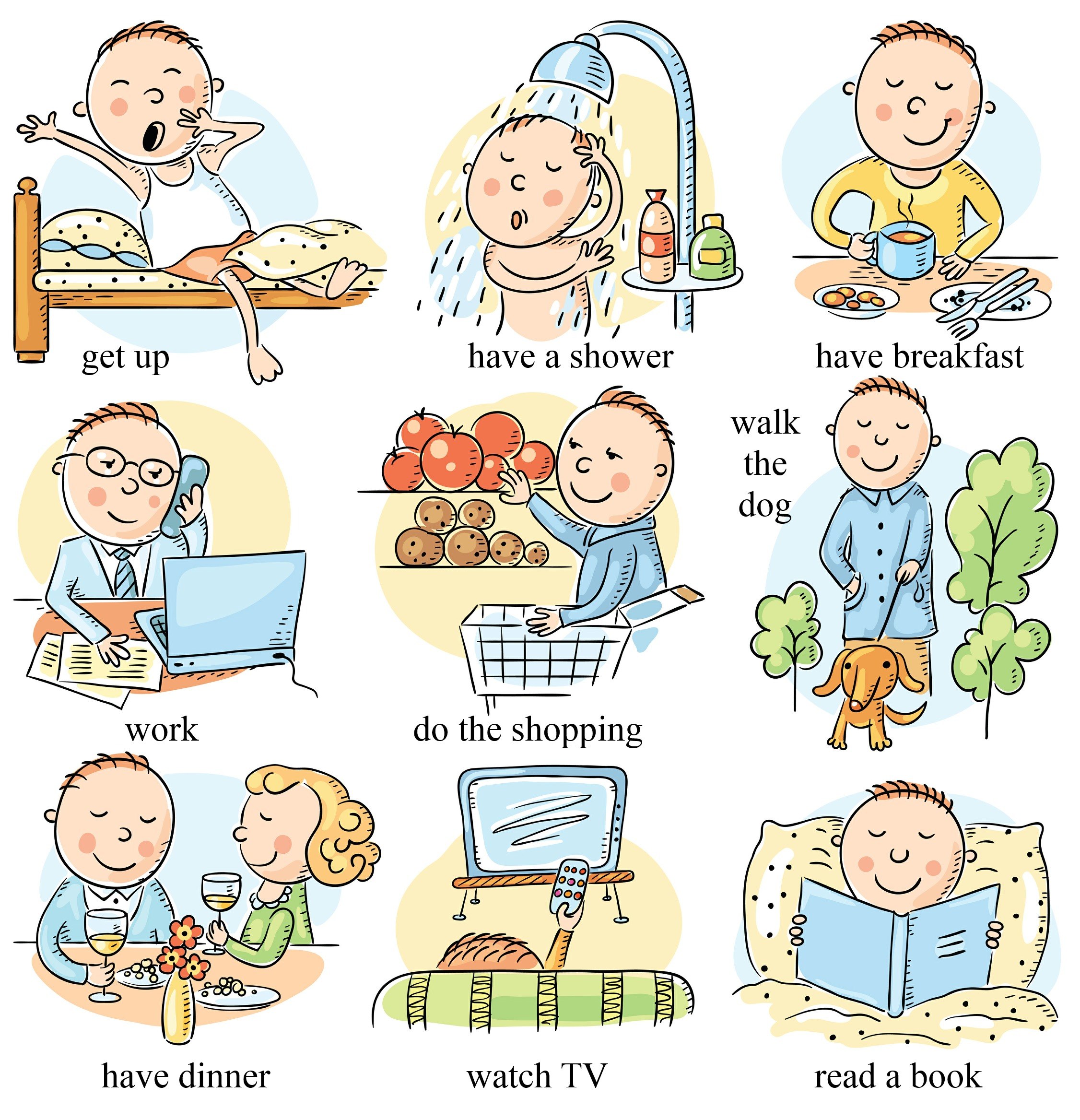
If you need the pronunciation, you should try the following video. In the second part of the video there is a quiz to practise the words. There appear the words and you have about 3 seconds to say the word before you hear it.
Daily activities – worksheets
If you would like to play the quiz on the full screen, click the following button.
Daily activities – quiz
There are four more activities in a print form. Print out the following worksheets and solve them:
Daily routine_worksheet
When the students know the vocabulary, I believe it is time to introduce the grammar.
Daily activities – song
You could just play the song to the students or you could ask them to listen and complete the lyrics
I wake up in the morning
Present simple tense – grammar
ADVERT:
[showmyadsa]
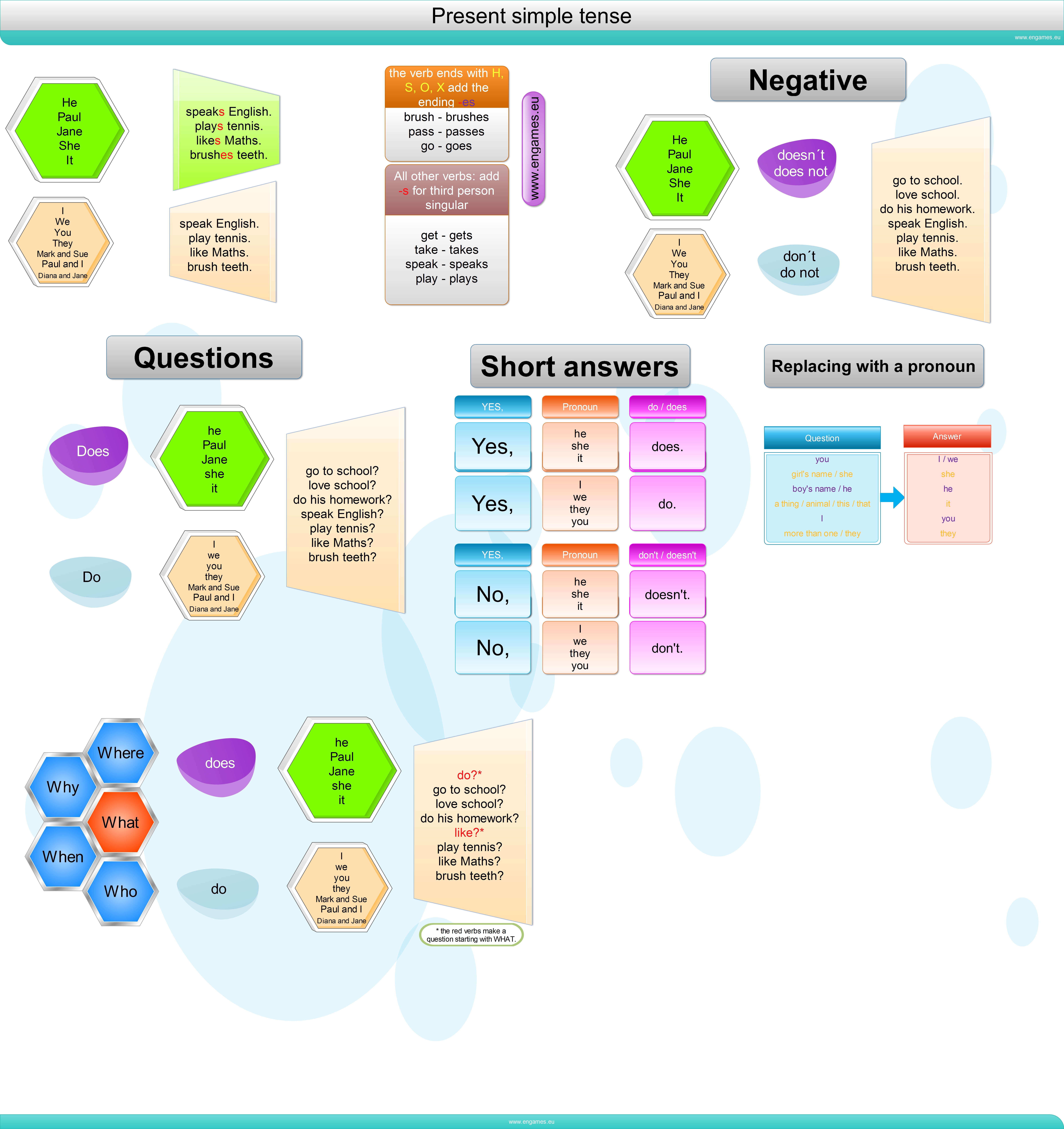
The infographic contains a lot of details. If you think it would be too much for your students, feel free to cut it into parts and present the different forms at different times.
Present simple tense – stories
Here, there are two more stories to highlight the grammar.
The first story explains why people use the ending -s in third person singular.
In English there is the sound PSST which is used to draw someone’s attention. A long long time ago people did not gossip. But then they started to speak about someone else but no one listened. But those people who gossiped needed attention so they started to use the PSST sound. They said:
Nikola (use students’ names, it is more fun and people listen) cook PSST very badly.
Adam play PSST football. Jane like PSST English. And so on.
And as people spoke quicker and quicker they soon reduced the PSST sound to the ending -s. So ever since when we speak about 1 person who is not me or you, we use the ending -s.
The other story explains the usage of DON’T.
Do you know what sound do bells make in English. DING DONG! It is very important because I will tell you a story that happened in the year 756. On 15th June suddenly three bells fell from a church tower in the English town Epston and they became alive. Suddenly they had legs and they walked around the country. And they spoke. People came to them and they asked them. “Do you live here?” “We,” started the bells but suddenly the sound DONG came from inside, “DONG live here.”
“Do you like music?” people asked.
“We DONG like music?”
“Do you do any work?”
“We DONG work.”
People spoke about these bells everywhere. “They dong like music.” “They dong work.” And as the time passed they changed the DONG sound to don’t and ever since we use DON’T in negative sentences. Later people added the form DOESN’T in third person singular.
And what happened to the bells? As they could not do anything they put them back on the tower and they never became alive again.
Present simple tense – grammar practice
The first quiz is a game calleed On Target. Your aim is to choose the correct answer and then shoot as many bad ducks as possible. You can shoot a bottle on the side too and win a bonus. The game is in flash and it plays on desktops only.
To play the game on the full screen, click the button below.
Present simple tense – On TargetThe second quiz is in HTML5 and thus it will play everywhere.
To play the game on the full screen, click the button below.
Present simple tense – QUIZPresent simple tense – Communicative activities
Remember the worksheets have to be your own.
We usually present just one tense to students. However, ever since I was a student I have always wanted to see a more complex picture and get more tenses at the same time. And as we have just finished the whole textbook with one of my elementary students an opportunity presented itself to sum up all the five tenses covered in the textbook. As a result, I created a special timeline which in combination with my explanation helped my student clarify the usage of all the tenses. I hope it will work for you too.
Five tenses – timeline
ADVERT:
[showmyads]
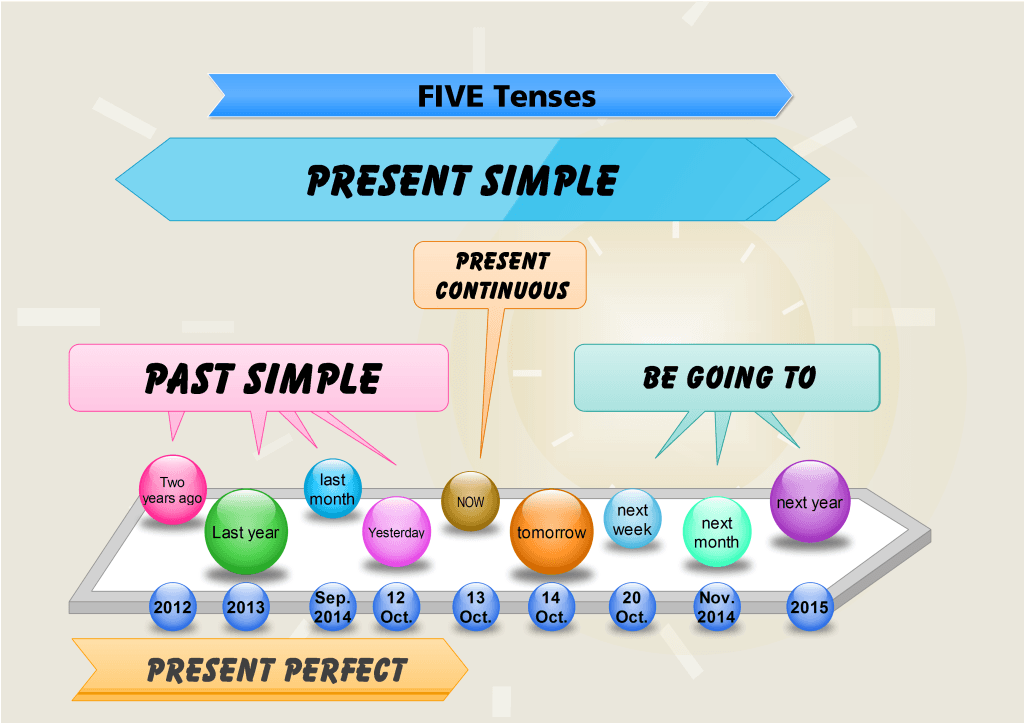
Five tenses – explanation
The pink shape belongs to past simple tense. There are three arrows pointing to different points in the past as the tense is used when we speak about finished events in the past.
The light blue is reserved for BE going to which is used for plans in the future (for elementary students I do not mind saying that it is the future tense 🙂 ).
The orange colour is for present continuous and the arrow points at NOW as the tense is used for speaking about the events happening at the moment of speaking (again, it is very simplified but for elementary students fine).
The yellow colour shows the usage of present perfect. It is used for past actions which are somehow connected with the present moment. Most frequently we use it to speak about experience (you say what you have experienced up to now).
Five tenses – Form
You can find a nice explanation of present simple and continuous on BBC pages.
Five tenses – Quizzes
ADVERT:
[showmyadsa]
If you want to try the quiz on the full screen click the button below:
Five tenses quiz
You can find more exercises to practise these five tenses at https://engames.eu/five-tenses-exercises/

